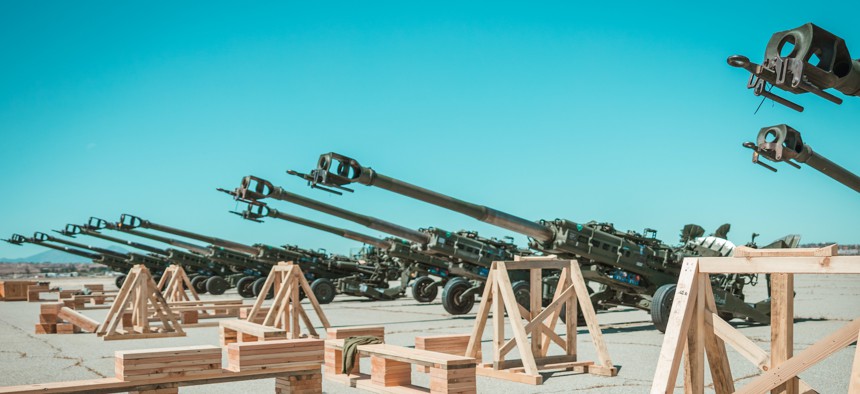
U.S. Marine Corps M777 155 mm howitzers are staged on the flight line prior to loading them into a U.S. Air Force C-17 Globemaster III aircraft at March Air Reserve Base, California, April 22, 2022.. The weapons were to be provided to Ukraine. U.S. Marine Corps / Staff Sgt. Royce H. Dorman
Pentagon Seeks to Update U.S. Weapons Stocks Depleted by Ukraine Donations
Defense Department's top acquisitions exec says Ukraine war is changing the way the U.S. thinks about stockpiles.
The U.S. military wants to update its stockpiles with newer weapons to replace some of the missiles and rockets it gave to Ukraine, the Pentagon’s top acquisition official said Friday.
Speaking to reporters for the first time since being sworn into the position last month, Bill LaPlante, defense undersecretary for acquisition and sustainment, said the plan is to gradually replenish U.S. stockpiles of the weapons given to Ukrainian forces who have been battling Russia since late February.
“The intent is to eventually go to a one-to-one replacement but … the reason it may not be directly one-to-one in the first tranche is just depends on when the system was bought,” LaPlante said during a Friday afternoon briefing at the Pentagon.
Some of the weapons the U.S. has given to Ukraine, such as Stinger shoulder-fired rockets and M777 howitzers, are no longer in production. Pentagon officials are evaluating the appropriate replacement for these types of weapons, LaPlante said.
“We're going through all of these calculations right now,” he said.
The Pentagon is also reviewing the assumptions it previously made about the ideal size of its current stockpile, because of the pressure the U.S. now finds itself under to maintain necessary levels of defense equipment.
“This is pretty unprecedented, the amount of munitions that are being used right now … so I'm sure we're all going to be re-examining our assumptions. ” LaPlante said. NATO partners are going through the same exercise, he said. “Everybody's going through this calculation.”
On the U.S. side, the Pentagon is beginning to shift to a continuous stockpile, to try and avoid the munitions shortfalls it experienced in Afghanistan and Syria, LaPlante said.
“The idea behind the fund … [is] basically almost a working capital replenishment fund, that we can have a continuous stockpile, because we can't predict exactly which weapons are going to be needed,” LaPlante said. “So it's a way to hopefully build up a little bit of a buffer for the next time.”
The Pentagon also must decide whether to buy the current version of the popular Javelin anti-tank missile or a newer version.
“[The] plan all along, before Ukraine, was to transition to a next generation of Javelin [with a] better seeker, better range, etc. Called the G model,” LaPlante said. “One of our decisions to make when we replenish it, we want to replenish it [and] probably we will, with the G model, so it's not quite a one for one replacement.”